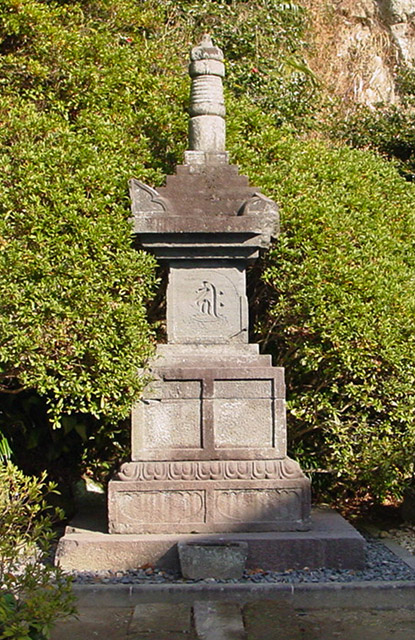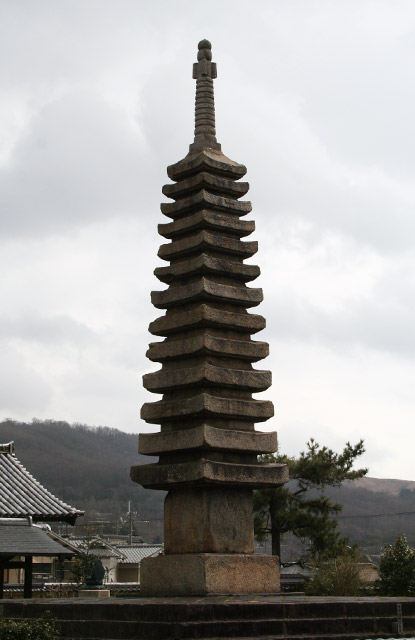| Also
read ishitou. A generic term for pagodas or stupas made of stone. It includes
multiple-storied stone pagodas@such as the five-ring pagoda *gorintou
ÜÖ, memorial or grave stones *kasatouba
}k, pagoda-like markers made of stone *itabi
Âè and *hide è`, and
egg-shaped or oval stones on a square on octagonal stone base, used originally
by the Zen T sect, and called *rantou
or *muhoutou ³D.
The multiple-storied monuments are frequently dedicated to Buddha and have
no interior, but some have space hewn out in which to place a very small
image. Like timber pagodas *tou
, stone pagodas always have an odd number of stories. Among those designated
as important cultural assets, many 13, 9, 7, and 5-storied stone pagodas
are extant and are in quite good condition. The only exception to the odd
number rule is the10-storied pagoda *Juujuutou \d at Injouji øÚ (1386) in Kyoto. The tallest
extant stone pagoda is 13-storied (14.12m) *juusanjuu-no-tou \OdÌ and constructed at Hannyaji Êá
(1253) in Nara. The finial *sourin
Ö, was replaced in the Shouwa period, but the original has
been preserved at the temple. Each tier is square and the corners curve
upward. The oldest sekitou have beautiful eave curvature called shinzori
^½è and the vertical, exterior surfaces are cut perpendicular to the ground.
Characteristically, the tiers are reduced in size as they rise, resulting
in a strongly slanting silhouette, seen in the Hannyaji stone pagoda. Although
almost all sekitou slant from bottom to top, the degree of slope
varies: 5-storied pagodas narrow only slightly, while 9- and 13-storied
ones narrow more obviously. The tiers are closely spaced and the lowest
tier is usually set on a high base. There is no exact uniformity in the
dimensions of the tiers, but their shapes are similar. Before the Kamakura
period, soft stone like tuff *gyoukaigan ÃDâ, was used,
but during the Kamakura period granite, kakougan Ô¼â, became popular.
Images of Buddha are often carved on the shaft of the first story. More
rarely, where stories are widely spaced, images or Sanskrit characters are
carved in all the spaces between the tiers. Construction dates of the pagodas
are also sometimes carved into the pagodas. Further examples include Hakubuji
õ (1324) in Kagawa prefecture, a 13-storied stone pagoda, 5.62m high.
This is the east pagoda, of an east-west pair. At one time it had doors
and is hollow to the 7th story. The large proportions of the double dais
emphasize the narrow size of the tiers and shaft, jiku-ishi ²Î. A
7- 8c 7-storied stone pagoda survives at Eizanji hR, in Nara. The entire,
original pagoda remains, even the finial. The lowest part of the high shaft
has Sanskrit carved on it. The 7-storied sekitou at Sekininji Ôl
(1318) in Shiga prefecture, 2.36m high, has foliate panels *kouzama
i·Ô on four sides of the base and Buddhist images on the shaft below the
first tier. |




